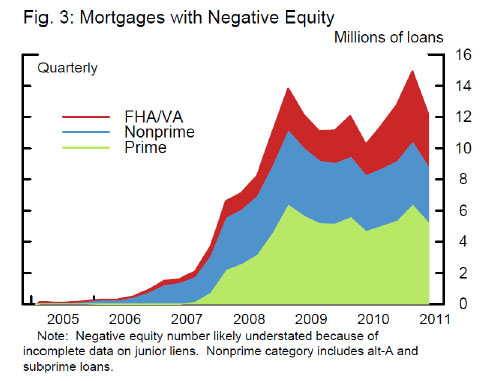Few things are more psychologically and financially damaging than the realization that you owe more on your home than it is worth. The real estate industry has forever advised potential buyers that you “can’t go wrong owing a home since prices always go up” – a myth that exploded as the housing bubble started to crash in 2006.
Housing prices have been in a free fall since 2006, virtually wiping out the entire gains in home equity seen over the last decade. Anyone who has purchased a home since 2000 is probably underwater, depending on the year of purchase.
According to the Federal Reserve, there are 12 million homeowners who owe more on their mortgage than their home is worth, but this estimate understates the reality of the situation. The Federal Reserve numbers only compare the estimated value of a home to the amount of mortgage debt on the property. However, anyone trying to sell a home at the same price that they paid for it will need to bring thousands of dollars to the closing to cover transactions costs for selling and moving from a home.
Transaction costs, including a 6% realtor sales fee, moving costs and associated fees and taxes can easily approach 10% of a home’s sales price. Selling a home that was originally purchased for $100,000 ten years ago and being sold today for the same amount means a seller potentially needs to show up at the closing with $10,000. Accordingly, the Federal Reserve estimate of the number of home owners in a negative equity position is vastly understated.
Making matters even worse, the Federal Reserve only considers first liens on homes when calculating negative home equity. If a homeowner took out a second mortgage when property values were higher, the negative equity in the home is even greater. Considering the transaction costs of selling a home and the huge number of homeowners who took out second mortgages during the housing boom, the Fed’s estimate of negative equity is probably low by millions of homeowners.
Federal Reserve Chairman Bernanke addressed the crisis of negative home equity in a white paper written for the Committee on Banking, Housing and Urban Affairs.
According to the Fed report, about $7 trillion in home equity values have been erased since the peak in 2006, resulting in reduced consumer consumption, a loss of confidence in the financial system and a flood of foreclosures. Contributing to the ongoing decline in housing prices is the huge inventory of foreclosed properties that must be sold which puts downward pressure on prices.
The Fed white paper also notes that the loss of wealth due to a decline in home prices has hit the middle income households the hardest. Unlike wealthier households that own other forms of wealth such as stocks, savings and businesses, most of the wealth of middle income Americans is based only on the equity in their homes.
FHA homeowners, who are typically middle income and usually make only the minimum down payment of 3.5% at purchase, are most at risk of negative equity. According to the Federal Reserve, there are currently about 3 million FHA borrowers whose homes are worth less than what they owe on the mortgage. Making matters ever worse, virtually every FHA borrower who makes only a 3.5% downpayment at purchase is instantly underwater on home equity after considering the upfront FHA insurance fee of 1% and the transaction costs involved in selling the property.
Any potential FHA borrower should seriously evaluate the purchase of a home given the decline in housing prices and the immediate negative equity situation they are putting themselves into. Any potential home buyer using FHA financing should be certain that the payments are manageable and that they intend to remain in the home for an extended number of years.
As noted in the Federal Reserve report, mortgage default has become the only option for many FHA borrowers. In the past, homeowners who needed to sell their homes due to payment difficulties or to move for a better job, had the options of refinancing or easily selling their homes for a profit. Unfortunately, many homeowners are now trapped in their homes with no easy way out and the problem will become even greater if home values continue to decline.

